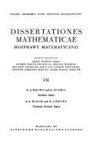Harmonic analysis on graphs via Bratteli diagrams and path-space measures
IF 0.8
3区 数学
Q1 MATHEMATICS
引用次数: 4
Abstract
The past decade has seen a flourishing of advances in harmonic analysis of graphs. They lie at the crossroads of graph theory and such analytical tools as graph Laplacians, Markov processes and associated boundaries, analysis of path-space, harmonic analysis, dynamics, and tail-invariant measures. Motivated by recent advances for the special case of Bratteli diagrams, our present focus will be on those graph systems $G$ with the property that the sets of vertices $V$ and edges $E$ admit discrete level structures. A choice of discrete levels in turn leads to new and intriguing discrete-time random-walk models. Our main extension (which greatly expands the earlier analysis of Bratteli diagrams) is the case when the levels in the graph system $G$ under consideration are now allowed to be standard measure spaces. Hence, in the measure framework, we must deal with systems of transition probabilities, as opposed to incidence matrices (for the traditional Bratteli diagrams). The paper is divided into two parts, (i) the special case when the levels are countable discrete systems, and (ii) the (non-atomic) measurable category, i.e., when each level is a prescribed measure space with standard Borel structure. The study of the two cases together is motivated in part by recent new results on graph-limits. Our results depend on a new analysis of certain duality systems for operators in Hilbert space; specifically, one dual system of operator for each level. We prove new results in both cases, (i) and (ii); and we further stress both similarities, and differences, between results and techniques involved in the two cases.基于Bratteli图和路径空间测度的图的调和分析
在过去的十年里,图的调和分析取得了蓬勃发展。它们位于图论和诸如图拉普拉斯算子、马尔可夫过程和相关边界、路径空间分析、调和分析、动力学和尾不变测度等分析工具的十字路口。受Bratteli图特例的最新进展的启发,我们现在的重点将放在那些具有顶点集$V$和边集$E$允许离散级结构的性质的图系统$G$上。离散级别的选择反过来又产生了新的有趣的离散时间随机行走模型。我们的主要扩展(极大地扩展了早期对Bratteli图的分析)是当所考虑的图系统$G$中的级别现在被允许为标准度量空间时的情况。因此,在度量框架中,我们必须处理转移概率系统,而不是关联矩阵(对于传统的Bratteli图)。本文分为两部分,(i)当能级是可数离散系统时的特殊情况,以及(ii)(非原子)可测范畴,即当每个能级都是具有标准Borel结构的规定测度空间时。将这两种情况放在一起研究的部分动机是最近关于图极限的新结果。我们的结果依赖于对Hilbert空间中算子的某些对偶系统的新分析;具体地说,每个级别都有一个操作员的双重系统。我们在(i)和(ii)这两种情况下都证明了新的结果;我们进一步强调了这两个案例中涉及的结果和技术之间的相似性和差异性。
本文章由计算机程序翻译,如有差异,请以英文原文为准。
求助全文
约1分钟内获得全文
求助全文
来源期刊
CiteScore
2.80
自引率
0.00%
发文量
8
审稿时长
>12 weeks
期刊介绍:
DISSERTATIONES MATHEMATICAE publishes long research papers (preferably 50-100 pages) in any area of mathematics. An important feature of papers accepted for publication should be their utility for a broad readership of specialists in the domain. In particular, the papers should be to some reasonable extent self-contained. The paper version is considered as primary.
The following criteria are taken into account in the reviewing procedure: correctness, mathematical level, mathematical novelty, utility for a broad readership of specialists in the domain, language and editorial aspects. The Editors have adopted appropriate procedures to avoid ghostwriting and guest authorship.

 求助内容:
求助内容: 应助结果提醒方式:
应助结果提醒方式:


